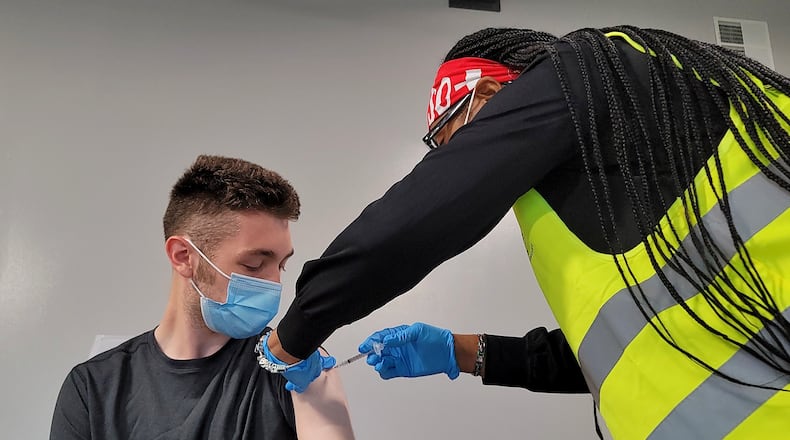This slower pace of vaccinations comes as the Biden administration’s original goal of 70% of adults vaccinated by Fourth of July has fallen short. There also are more transmissible variants of COVID-19 spreading, primarily among the unvaccinated.
The efforts locally are part of a nationwide push.
“We’re not just going to do the mass vaccination sites,” Health and Human Services Secretary Xavier Becerra told the Associated Press. “It’s door to door. It’s mobile clinics. We’re doing vaccinations at church, the PTA meeting, the barber shop, the grocery store.”
What incentives work to help people get vaccinated?
Incentives and outreach can help.
Overall, a national Kaiser Family Foundation survey from June 8 to 21 found out of those not vaccinated yet:
- 23% said they’d be more likely if they were entered into a $1 million lottery;
- 17% said they’d be more likely if a mobile clinic came to their neighborhood;
- and 13% of unvaccinated parents said they’d be more likely if they were provided free childcare while they get vaccinated and recover from any side effect.
The survey findings have reinforced tactics like local mobile clinics that for months now have been bringing vaccines to restaurants, festivals, worksites and more.
“We’re getting what we think of as a good response to them (mobile clinics), even though the numbers are not high,” said Dr. Michael Dohn, medical director at Public Health - Dayton & Montgomery County. “Because we’re trying to get to the people who either had difficulties getting the vaccine or have only just recently been persuaded to get the vaccine. And so we’re not looking to have very large numbers at this point.”
Vandalia Division of Fire and the Butler Twp. Fire Department, working with Public Health, received strong interest in a new a COVID-19 vaccination house call program.
Scott Jacobs, risk reduction coordinator, said they had a theory that their lower vaccination rates in the community were partially from older people who couldn’t leave the home, but with the house call program they’ve also served younger residents who for different reasons hadn’t been able to get out to a vaccine clinic.
“They can meet us in their home where they were comfortable to get that vaccine done,” Jacobs said.
Some nursing homes and other long-term care communities have taken this carrot approach. HarborChase, which has a facility in Beavercreek, said employees can enter drawings for cash prizes and a 2021 Nissan Versa.
“It was our goal to open our communities fully and safely, and we knew that our associates would play a very large role in accomplishing this objective,” said Kim Lewis, Chief Operations Officer of Harbor Retirement Associates. More than 80% of employees have been voluntarily vaccinated against COVID-19, Harbor reports.
What else helps?
Full FDA approval of a vaccine also could move the needle, particularly with people who want to wait and see before they get the shot.
While about 31% of unvaccinated adults say they would be more likely to get a vaccine if one of the vaccines currently authorized for emergency use received full approval by the FDA, that rises to nearly half of those in the “wait and see” group.
In addition, employer support seems to help.
Kaiser Family Foundation noted that workers who say their employer either encouraged workers to get vaccinated or gave paid time off for vaccination are more likely to report being vaccinated.
Who is vaccinated? And who isn’t vaccinated yet?
About 47% of Ohioans have at least one dose of a COVID-19 vaccine. This includes more than 70% of those 60 and older.
But the pace of shots has slowed. While in late March, on a strong day more than 100,000 were vaccinated, now closer to 7,000 get vaccinated on higher day. The seven-day moving average is close to 5,000 Ohioans getting a shot a day.
Dohn said we hit a transition point as we moved from people who eagerly wanted a vaccine to people who for different reasons are going to take a longer time to get a vaccination.
“I think we may have been a little surprised and disappointed that that inflection point came as early as it did, in terms of the percent of the population that have been vaccinated,” Dohn said.
Only 3% told Kaiser they aren’t vaccinated but intend to get the vaccine as soon as they can.
About 10% of adults say they will wait and see. The “wait and see” group has shifted from 31% of adults in January but only slightly moved from 12% in May.
Dohn said we don’t know how long people will want to wait and see as they process their decision.
“I think we’re into sort of an unpredictable stage here,” Dohn said.
About 6% of U.S. adults said they will get a vaccine only if required and about 14% say they will definitely not get vaccinated.
About half of unvaccinated adults surveyed by Kaiser Family Foundation said they felt cases are so low that there’s no reason for more people to get vaccinated.
Vaccines have dramatically lowered case counts and hospital strain. But if people who aren’t vaccinated get infected, they remain just as vulnerable to getting severely sick as before.
When the foundation asked about the main reason people haven’t gotten vaccinated, the top answers were: the vaccine is too new, they were worried about side effects, they “just don’t want to get the vaccine,” don’t trust the government, or don’t think they need the COVID-19 vaccine.
Demographic differences in vaccination point toward some complex barriers to vaccination.
Black residents are vaccinated at lower rates than white residents and have been hospitalized at higher rates, though the metro area had higher than average vaccine rates early on for African Americans and other minority populations. Dohn said this reflects the relationships that local churches and medical providers had prior to the vaccine rollout.
“During the disaster or the emergency is the worst possible time to be exchanging business cards. All the success that you have is often predicated on the relationships that are pre-existing,” Dohn said.
Vaccination rates are also found to be lower with rural residents and white evangelicals.
Dr. Zach Jenkins, associate professor of pharmacy practice at Cedarville University, said rural communities were disproportionately impacted by the lockdown measures that were put in place this past year, such as blue collar jobs that can’t work from home and challenges with no in-person school. Also faith-based communities either experienced or observed church closures and other restrictions limiting how they worship.
“It also didn’t help that there was an explosion of information about the virus that seemed to change on a daily basis,” Jenkins said. “When you layer the political and cultural divides on top of these issues, you can start to understand why there is so much hesitancy within these communities.”
Jenkins said outreach needs to meet individuals in these communities where they are at and hear their concerns for what they are.
“Making members of these communities feel small for their questions and concerns does nothing to establish trust.” Jenkins said. “Compassion builds trust more than education ever will. When we misorder that, we create disorder.”
What about the Delta variant?
The Delta variant is present in Ohio and has made headlines because it spreads more easily than the original virus strain that causes COVID-19.
This adds to the risk of the unvaccinated, particularly those who have resumed regular activities like being in unmasked indoor crowds.
But the good news for the vaccinated is that the vaccines are still doing a good job blocking the variant.
“It’s the way out of the pandemic,” ODH Chief Medical Officer Dr. Bruce Vanderhoff previously said. “It’s our best protection, including against the delta variant.”
In rare cases people who are vaccinated get sick. The majority so far only get mildly ill and the vaccines generally work as hoped by protecting them from the worst of COVID-19.
The longer the virus circulates in unvaccinated people, the higher the likelihood down the road that vaccine effectiveness will wane. That’s a factor in why health officials have urged vaccines for all.
“It also seems that when the variant does infect previously-vaccinated people, they tend to have less severe infections than they might otherwise experience,” Jenkins said. “With that being said, there is some concern over the potential for other mutations (I.e., the so-called “Delta Plus”) of this variant to escape vaccines.”
How do I get my child vaccinated against COVID-19 in time for school?
Parents who want their teens to be fully vaccinated against COVID-19 before the school year, the time to start is soon.
Dayton Children’s Hospital recently highlighted that a child who gets the first shot on July 11 could get the second dose Aug. 1 and would be considered fully vaccinated Aug. 15.
Associated Press contributed to this report.
About the Author

